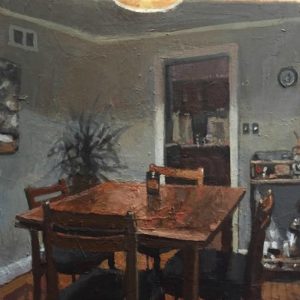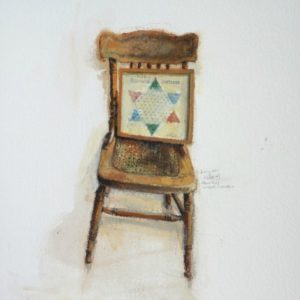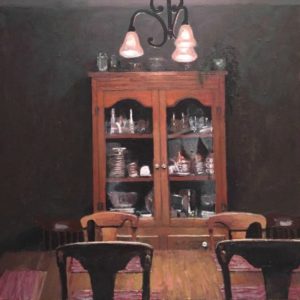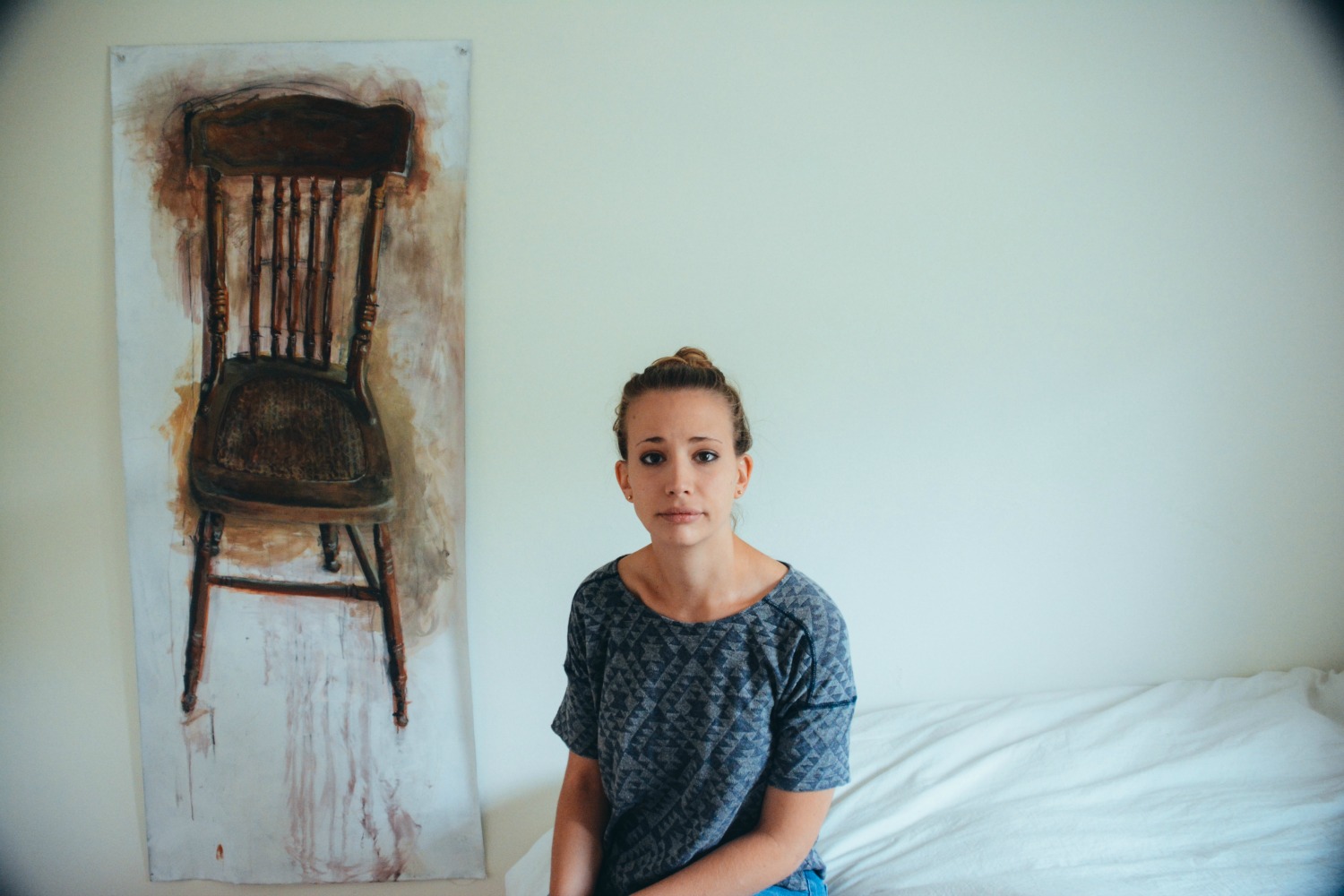The Seattle School has reserved a portion of its public space on both the second and third floors to display and honor art created by students, staff, faculty, alumni, and artists from the greater Seattle area. These gallery spaces are curated by students in conversation with faculty and seek to represent an experience of our life together through a variety of mediums for a public audience. This term, we are thrilled to feature Maggie Hubbard’s Chair With in the second floor common area and Davia Campbell’s Long Lay the World in the third floor hallway. Both galleries will be on display throughout the spring term.
Here, Maggie Hubbard talks about her work, immanence, transcendence, and the hope of finding the divine in the ordinary. (And in case you missed it, you can read our interview with Davia Campbell here.)
Can you tell us a little about how you ended up where you’re at today?
I am from the suburbs of Chicago and just moved to Seattle this summer. I studied illustration in college and have spent my time since graduating by working odd jobs and painting. My art practice has been strongly influenced by my family and the community of artists around me. Part of that art community decided to move to Seattle, and I made the decision to go with knowing that I require encouragement and accountability if I am to continue painting. So, here I am living in Seattle with a tiny community of artists that constantly pushes me toward creating.
 Here’s an impossibly broad question, but where do your ideas come from? In the case of Chair With, what made you want to focus on such a (seemingly) ordinary thing?
Here’s an impossibly broad question, but where do your ideas come from? In the case of Chair With, what made you want to focus on such a (seemingly) ordinary thing?
I have always been drawn to quiet objects and spaces. They’re not flashy, they get passed by, but when I paint them I am entirely captivated. I’m drawn to ordinary things because they’re readily available to paint. I paint mostly from life, meaning directly sitting down with an object or space and painting what I see, no cameras or technology involved. Shortly after moving to Seattle I found myself scrounging around for subject matter that would connect with my previous body of work, and I found these two chairs that reminded me a lot of the home I grew up in.
That seems to be a theme of your work: taking something familiar, even mundane, and looking at it in a different way. Is that an intentional focus for you?
That is almost my exact focus. Though I would say I am not setting out to look at the mundane differently, I’m simply looking at what is familiar. I think it is within the process of painting and recreating that the ordinary begins to look different.
It is within the process of painting and recreating that the ordinary begins to look different.
Drawing beauty from ordinary objects seems like it’d require significant amounts of attention directed toward something most of us don’t think twice about. How does that change the way you view the world and the things around you?
Looking closely at ordinary objects is really more of a practice than a natural way of seeing for me. There is certainly a lot of attention and focus that goes into creating a representational image. For example, a chair: having to correctly recreate the angles of the supports, the colors within the wood grain, the highlights that are only on certain parts of the chair where the sheen still allows for the light to be reflected—that takes a lot of concentration. It means looking at my canvas and the chair in front of me for about five hours at a time. I can guarantee you I would never stare at a chair for five hours if I were not painting. It’s really only within those times of intentional observation that I am conscious of the divine being manifested inside the mundane.
 I was struck by the intimacy of this collection—I’m thinking right now of the chairs with personal items on them, like the one with “Aunt Sue’s Chinese Checkers.” Can you say a little more about the process of deciding what to include in these pieces, and how much of yourself, or your personal and family context, went into each one?
I was struck by the intimacy of this collection—I’m thinking right now of the chairs with personal items on them, like the one with “Aunt Sue’s Chinese Checkers.” Can you say a little more about the process of deciding what to include in these pieces, and how much of yourself, or your personal and family context, went into each one?
Gosh, I would say all of myself and family context goes into these pieces. I don’t think I will know all the aspects of what went into this body of work for a while because I am still very present in the midst of all the ideas, relationships, emotions, philosophies, and experiences that went into these paintings.
I didn’t have a specific goal in mind for these paintings; the chairs remind me of my childhood home I just moved away from, and the objects on the chairs are all relics of my father, who passed away three years ago. As I created the chair-objects paintings, my thought process started shifting toward my mom who is now living in a house by herself, my brother who was facing the end of his marriage, and also my own state of trying to brave the world as a single woman in the midst of what feels like many married couples. This shift got me thinking a lot about security, loneliness, and community, so I focused my attention more to dining room tables, homes, and chairs.
This might not be something you think about with your art, but are there are any particular feelings or responses you hope people will experience when they view this work?
One thing I haven’t mentioned yet is the idea of immanence and transcendence being at play within my work. For my own understanding of the two words I boiled down their definitions to immanence—meaning the divine manifested inside the mundane, and transcendence—meaning the divine existing outside the mundane.
 There was one morning not too long ago where I woke up and the first thing my eyes focused on was my iPhone screen. After scrolling through all of my not-so-important newsfeeds of mediocre updates, I looked just to the right of my phone and saw a really nice patch of light on this antique metal bread box that my dad had bought to put bread in but my mom hated because it was old and rusty and had sharp edges. That box is sitting on my bookshelf and contains important papers and mementos. I looked at that solid object, sitting on a sturdy bookshelf, resting in the corner of an organized room, being touched by the morning winter Seattle sunshine, and in that moment I was completely aware of the present world around me. I felt lucky, I felt good about not looking at a bright moving screen, and I almost felt like I was transported to another place. That type of moment is what I experience at some point in painting the mundane things around me. When I look at the mundane I see aspects of the divine. And yet, those movements are transcendent. While observing plain spaces, I am transported to an otherworldly state of mind.
There was one morning not too long ago where I woke up and the first thing my eyes focused on was my iPhone screen. After scrolling through all of my not-so-important newsfeeds of mediocre updates, I looked just to the right of my phone and saw a really nice patch of light on this antique metal bread box that my dad had bought to put bread in but my mom hated because it was old and rusty and had sharp edges. That box is sitting on my bookshelf and contains important papers and mementos. I looked at that solid object, sitting on a sturdy bookshelf, resting in the corner of an organized room, being touched by the morning winter Seattle sunshine, and in that moment I was completely aware of the present world around me. I felt lucky, I felt good about not looking at a bright moving screen, and I almost felt like I was transported to another place. That type of moment is what I experience at some point in painting the mundane things around me. When I look at the mundane I see aspects of the divine. And yet, those movements are transcendent. While observing plain spaces, I am transported to an otherworldly state of mind.
One could make the argument that my paintings are pretty ordinary. My Chair With paintings are low grade pieces of plywood found in an old church that I covered with paint and some scratches of pencil. Plywood, paint, and some pencil. Not too exciting. But those humble slabs of plywood might possibly contain some semblance of the divine. They could be relating to or affecting the human spirit or soul. By displaying this work I am presenting the chance for a material thing to penetrate our understanding of what rests in the ordinary.
Maggie Hubbard received a BS in Illustration at Indiana Wesleyan University in 2013. Hubbard has been included in various exhibitions across the Midwest from the suburbs of Chicago to multiple cities in Indiana. Now residing in Seattle, Hubbard continues to work and paint within a small community of artists. Hubbard’s work explores the relationship between the earthly and the spiritual by finding otherworldly characteristics in mundane objects and spaces.

